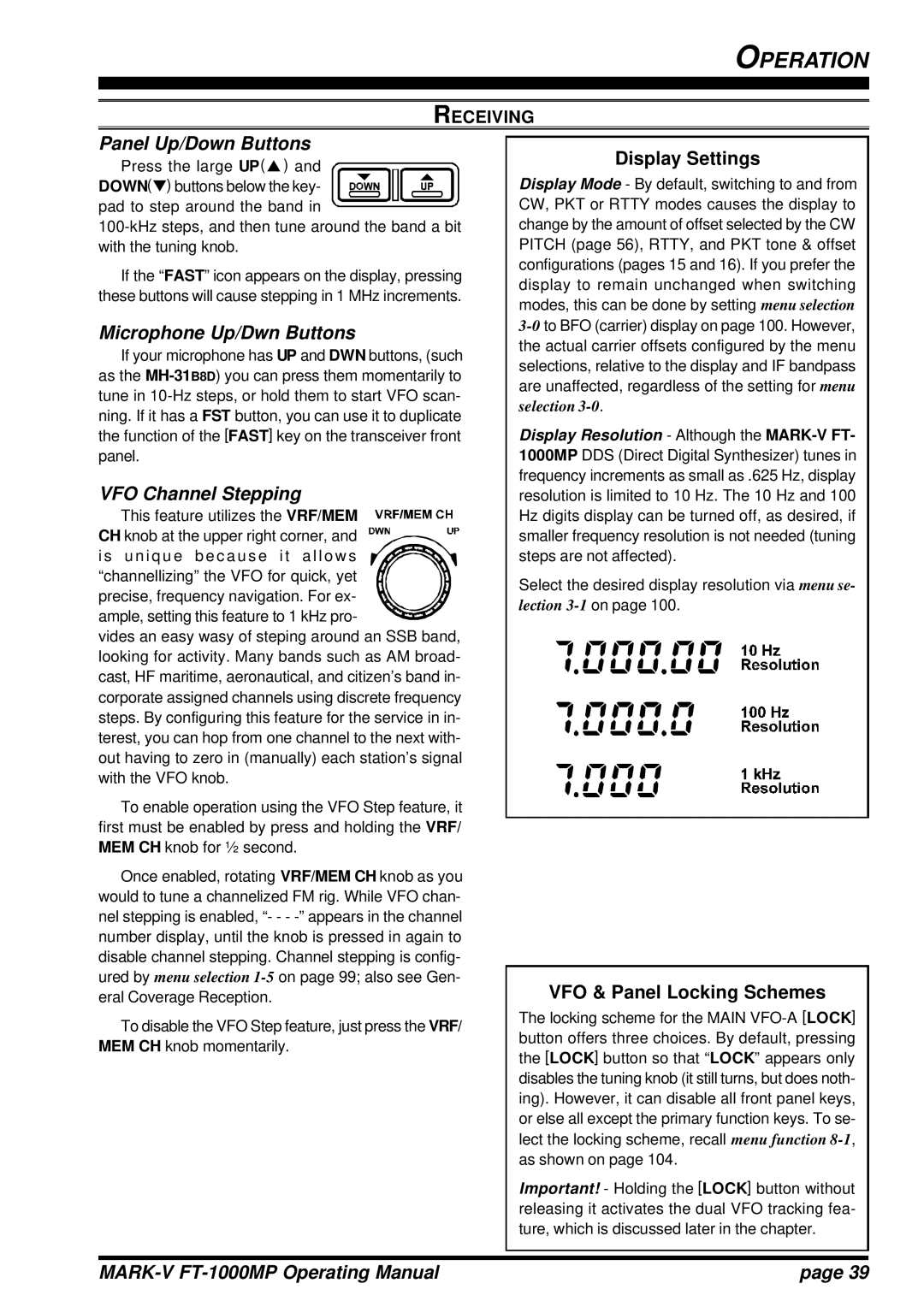
OPERATION
RECEIVING
Panel Up/Down Buttons
Press the large UP(p) and ![]()
![]()
![]()
![]() DOWN(q) buttons below the key-
DOWN(q) buttons below the key- ![]()
![]()
![]()
![]()
![]()
![]()
![]()
![]()
![]() pad to step around the band in
pad to step around the band in ![]()
![]()
![]()
![]()
If the “FAST” icon appears on the display, pressing these buttons will cause stepping in 1 MHz increments.
Microphone Up/Dwn Buttons
If your microphone has UP and DWN buttons, (such as the
VFO Channel Stepping
This feature utilizes the VRF/MEM ![]()
![]()
![]()
![]()
![]() CH knob at the upper right corner, and
CH knob at the upper right corner, and ![]()
![]()
![]()
![]()
![]()
![]()
![]()
![]() i s u n i q u e b e c a u s e i t a l l o w s
i s u n i q u e b e c a u s e i t a l l o w s ![]()
![]()
![]()
![]()
![]()
![]()
![]()
![]()
![]()
![]()
![]()
![]()
![]()
![]() “channellizing” the VFO for quick, yet
“channellizing” the VFO for quick, yet ![]()
![]()
![]()
![]() precise, frequency navigation. For ex-
precise, frequency navigation. For ex- ![]()
![]()
![]()
![]()
![]()
![]() ample, setting this feature to 1 kHz pro-
ample, setting this feature to 1 kHz pro- ![]()
![]()
![]()
![]()
![]()
![]()
![]() vides an easy wasy of steping around an SSB band, looking for activity. Many bands such as AM broad- cast, HF maritime, aeronautical, and citizen’s band in- corporate assigned channels using discrete frequency steps. By configuring this feature for the service in in- terest, you can hop from one channel to the next with- out having to zero in (manually) each station’s signal with the VFO knob.
vides an easy wasy of steping around an SSB band, looking for activity. Many bands such as AM broad- cast, HF maritime, aeronautical, and citizen’s band in- corporate assigned channels using discrete frequency steps. By configuring this feature for the service in in- terest, you can hop from one channel to the next with- out having to zero in (manually) each station’s signal with the VFO knob.
To enable operation using the VFO Step feature, it first must be enabled by press and holding the VRF/ MEM CH knob for ½ second.
Once enabled, rotating VRF/MEM CH knob as you would to tune a channelized FM rig. While VFO chan- nel stepping is enabled, “- - -
To disable the VFO Step feature, just press the VRF/ MEM CH knob momentarily.
Display Settings
Display Mode - By default, switching to and from CW, PKT or RTTY modes causes the display to change by the amount of offset selected by the CW PITCH (page 56), RTTY, and PKT tone & offset configurations (pages 15 and 16). If you prefer the display to remain unchanged when switching modes, this can be done by setting menu selection
Display Resolution - Although the
Select the desired display resolution via menu se- lection
VFO & Panel Locking Schemes
The locking scheme for the MAIN
Important! - Holding the [LOCK] button without releasing it activates the dual VFO tracking fea- ture, which is discussed later in the chapter.
| page 39 |
